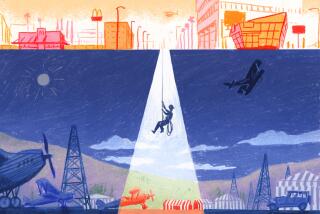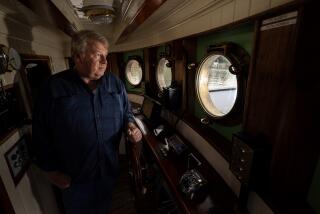Anniversary Stirs Flights of Memory
He was one of those intrepidly resourceful American boys so admired just before the Great War--handy with a wrench and screwdriver, intrigued by the newfangled inventions of the times and ready to put his own soaring ideas into action. He was, you could say, Sierra Madre’s own Frank Merriwell, the hero of a series of boys’ books of that era.
It was not surprising, then, that Rudolph Hartman, teen-age adventurer and engineer, was enchanted by the new flying machines.
“In those days, even a short flight was a big thing,” said Hartman, a spirited 91-year-old now recovering in the Sierra Madre Skilled Nursing Facility from a stroke he suffered two months ago. “Flying across the country--that was a Jules Verne idea. It was something out of ‘Around the World in 80 Days.’ ”
‘Nut on Aviation’
For a self-styled “nut on aviation” who had built his own airplane by the time he was 13, the most electrifying event of the era was the cross-country flight of the Vin Fiz, Hartman said Tuesday.
Its arrival in Pasadena on Nov. 5, 1911, was an epic event. A big, awkward-looking biplane with framework fuselage and wings that spanned 31 feet, the Vin Fiz, named after a soft drink made by Armour, the company that sponsored the flight, arrived in the afternoon. It almost fell out of the sky onto Tournament Park, to a tumultuous reception by a crowd of 10,000. It was the first flying machine ever to cross the country.
According to Beverly Hills writer Richard Epstein, author of “The Flight of the Vin Fiz,” the accident-plagued flight almost ended disastrously.
“As the plane touched down, a tire blew, the engine gave out and a wing crumpled,” said Epstein, who writes under the nom de plume E. P. Stein.
Veteran Pilot
Out stepped the pilot, the fearless Calbraith Perry Rodgers, who had already endured 20 crashes and a series of weather delays to get to the West Coast from Sheepshead Bay, N.Y.
According to Epstein, the crowd rushed the biplane, tearing souvenirs from the pilot’s clothes and the plane itself.
The 75th anniversary has been observed in a number of ways this week, most notably with the arrival of a scaled-down replica of the original plane, after a trouble-plagued, month-and-a-half transcontinental trip of its own.
A banquet observing the event and honoring Jim Lloyd, the cross-country pilot of the new Vin Fiz, which was also built by Armour, was scheduled Wednesday night in Pasadena, as well as a series of ceremonial events in Long Beach, where the flight ended Wednesday. Long Beach was the designated final stop because Pasadena has no landing field.
Weathering the Elements
In following the flight of the original Vin Fiz, modern biplane flyer Lloyd, a 37-year-old research engineer from Fishkill, N.Y., has dodged thunderstorms in Ohio and Indiana, been grounded by flood-inducing rains in Missouri and Oklahoma and, as he neared the end, been pinned down by gusty desert winds in San Bernardino County.
“Weather conditions were miserable all across the country,” said a frustrated Lloyd on Monday, four short hops away from his destination in Long Beach, waiting for the winds to let up in Banning. “I saw a lot of soggy farms out there, a lot of farmers who couldn’t farm in the middle of harvest.”
Lloyd finally reached Long Beach after a brief mishap on the Pomona-El Monte leg of the journey. The plane had to get an emergency propeller replacement, according to the flight’s sponsors.
Hartman observed the occasion with some freewheeling reminiscences about the Vin Fiz and and its pilot, including one of a lucky one-on-one encounter with Rodgers himself. He also remembered being a flight buff in the early days of aviation.
It was maybe a poor alternative to participating in all the ceremonial festivities--Hartman had to send his regrets to organizers of the events--but it stimulated his interest anyway.
Fond Memories
Hartman had followed the progress of the 1911 flight in the newspapers, he said as he fiddled with his hearing aid (“I gotta turn on my left ear”). He had stood at Tournament Park for the flight’s glorious finale and then returned to the scene a day or so later.
“I jumped on my bike and pedaled over to Pasadena,” said Hartman, who eventually became a pharmacist. “I found Rodgers himself there.”
The pilot gave the young acolyte a quick tour of the Vin Fiz.
“He was awfully gracious to me,” Hartman said. “But I was much more interested in the plane than I was in him. The motor was not as elegant as motors are today. Cylinders were just made of castiron in those days, jacketed, as I recall, with sheet copper. My eyes were this big, seeing a plane that had flown that far.”
Experienced Aviator
Of course, Hartman was no mere upstart with a vague interest in airplanes but a member of the flying brethren. By the time the Vin Fiz arrived in Pasadena, the youthful
flying fanatic, who haunted the air shows in West Los Angeles, had already taken a pass or two at the sky in his own plane.
He had built a replica of the French Bleriot, the skeletal little monoplane which had just been the first flying machine to hop the English Channel.
“I don’t know why I picked the Bleriot,” said Hartman. “Everything was biplanes in those days. But I started building the ribs ofthe plane up in the attic.”
That was when the family still lived in Santa Monica. By the time his pharmacist father bought the family business on North Baldwin Avenue in Sierra Madre, the plane lacked only a motor.
The arrival of Hartman’s Bleriot must have been one of the strangest sights that the little town of Sierra Madre had ever seen.
“A friend and I towed it up to Sierra Madre on our bicycles,” Hartman recalled. “Wilshire Boulevard had just opened up at that time. We stopped for lunch at 1st Street and Figueroa, then headed out Huntington Drive.”
Flying Through Mountains
But Sierra Madre hadn’t seen anything yet. Not satisfied with watching his plane sitting idle in the backyard, Hartman and friends towed it up Baldwin Avenue into the foothills of the San Gabriel Mountains and, with young Hartman tucked into the cockpit, sent him roaring downhill.
“I could get up to about 20 feet off the ground,” Hartman said. “On a good flight, I’d cover 55 or 60 feet. It was quite a thrill.”
Hartman’s daredevil flights down Baldwin and Auburn Avenues became common sights for startled Sierra Madre residents--until one black day when the plane was destroyed in a windstorm.
“I had it tied to a tree in the backyard,” Hartman said. “A whirlwind came along and turned it into kindling.” All that remains now is a piece of the plane’s wingstrut.
Of course, Hartman did not fret for long. He developed a new interest.
“Automobiles came along about that time.” he said. By the time of the plane’s demise, he had acquired a 1909 Rambler, a two-cylinder speedster.
“On the Fourth of July, the city would let us take the mufflers off our cars, and we’d have races up through the hills,” Hartman recalled.
A more mundane reality, unfortunately, soon asserted itself. Hartman went to USC to become a pharmacist, following in his father’s footsteps.
More to Read
Sign up for The Wild
We’ll help you find the best places to hike, bike and run, as well as the perfect silent spots for meditation and yoga.
You may occasionally receive promotional content from the Los Angeles Times.






